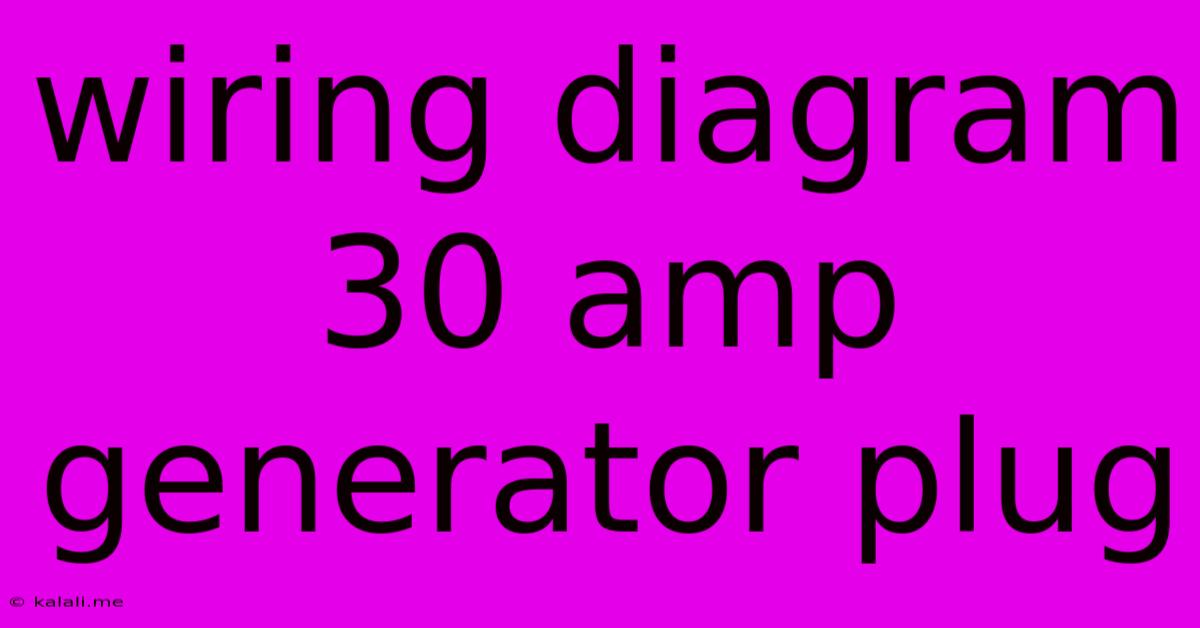Wiring Diagram 30 Amp Generator Plug
Kalali
Jun 04, 2025 · 3 min read

Table of Contents
Understanding and Using a 30-Amp Generator Plug Wiring Diagram
This article will guide you through understanding the wiring diagram for a 30-amp generator plug, a crucial component for safely connecting your generator to your home's electrical system during a power outage. We'll cover the standard wiring configuration, safety precautions, and troubleshooting tips. Understanding this diagram is vital for preventing electrical hazards and ensuring the safe operation of your generator.
A 30-amp generator plug, typically a 4-prong or 5-prong L14-30 configuration, is designed for higher-power applications compared to a standard 15 or 20-amp plug. This makes it suitable for powering essential appliances and systems during extended power outages. However, proper wiring is paramount to avoid electrical shocks or equipment damage.
Understanding the 30-Amp Generator Plug Wiring
The 30-amp generator plug uses a specific color-coded system for its wiring:
- Hot 1 (L1): Usually black. This carries one phase of the AC power.
- Hot 2 (L2): Usually red. This carries the second phase of the AC power. Note that this is only present in some configurations (240V).
- Neutral (N): Usually white. This carries the return path for the electrical current.
- Ground (G): Usually green or bare copper. This provides a safe path for fault currents to ground, protecting against electrical shocks.
Important Note: The exact arrangement might vary slightly depending on the manufacturer and the type of plug (e.g., L14-30, TT-30). Always refer to the specific wiring diagram provided with your generator and transfer switch.
Interpreting the Wiring Diagram
A typical wiring diagram will show the internal connections within the plug itself, and how they connect to the wires coming from the generator's output. It will clearly illustrate which wire connects to which terminal on the plug. This information is essential for correct wiring and safe operation. A visual diagram is far more instructive than a verbal description, hence always consult the manufacturer’s provided diagram.
Safety Precautions When Working with Generator Wiring
Working with electrical wiring requires utmost caution. Always:
- Turn off the generator: Before connecting or disconnecting any wires, ensure the generator is completely switched off and unplugged.
- Use appropriate tools: Employ insulated tools to avoid electrical shocks.
- Wear protective gear: Safety glasses and gloves are recommended.
- Consult a qualified electrician: If you're uncomfortable working with electrical wiring, it's always best to consult a qualified electrician. Improper wiring can lead to serious electrical hazards.
- Understand local codes: Familiarize yourself with local electrical codes and regulations.
Troubleshooting Common Issues
If your generator isn't powering your appliances correctly, the problem could be with the wiring:
- Check the connections: Ensure all connections are secure and that no wires are loose or damaged.
- Inspect the wires: Look for any signs of fraying, cuts, or burn marks on the wires.
- Test the circuit: Use a multimeter to check the voltage and continuity of the circuit.
- Verify the circuit breaker: Make sure the appropriate circuit breaker is not tripped.
By understanding the wiring diagram of your 30-amp generator plug and following safety procedures, you can ensure the safe and efficient operation of your generator during power outages. Remember, safety should always be the top priority when working with electricity. If in doubt, consult a professional electrician.
Latest Posts
Latest Posts
-
How To Get Cigarette Smell Out Of Apartment
Jun 06, 2025
-
Lutheran Vs Campus Crusade For Christ Beliefs Difference
Jun 06, 2025
-
Gas Pump Pre Pay Time Out Refund
Jun 06, 2025
-
Well Water Pressure Drops Then Comes Back
Jun 06, 2025
-
What Should My Car Battery Voltage Be
Jun 06, 2025
Related Post
Thank you for visiting our website which covers about Wiring Diagram 30 Amp Generator Plug . We hope the information provided has been useful to you. Feel free to contact us if you have any questions or need further assistance. See you next time and don't miss to bookmark.